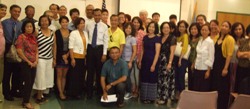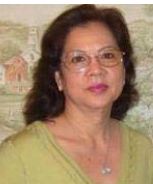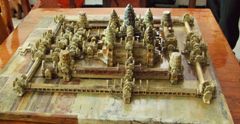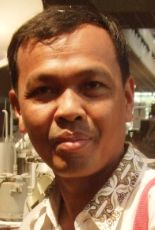The Rolous Group
The Rolous Group
Roluos is the site of Hariharalaya, the first capital of Khmer Empire north of Tonle Sap. There, the Khmer Kings built several temples known today as the "Rolous Group". They are the earliest permanent structures built by Khmer. They mark the beginning of classical period of Khmer civilization, dating from the late 9th century. Some were totally built with bricks, others partially with laterite or sandstone. At the present time, it is composed by three major temples: Bakong, Lolei and Preah Ko, and tiny Prasat Prei Monti. At both Bakong and Lolei there are contemporary Theravada Buddhist monasteries.
Prasat Preah Ko
King Indravarman I (877 '889 AD) began extensive building projects, most importantly, the temple of Preah Ko and the irrigation systems, a 6.5 sq Km baray (reservoir) at Roluos. Consecrated to gods in 880, Preah Ko is six brick-built towers dedicated to the memory of his parents, the dynasty founder, Jayavarman II, and his wife. He was one of the truly great Khmer rulers. He was not a crown prince, but rather a nephew of Jayavarman II 's Queen. During his reign, the baray was the first stage of an hydraulic irrigation system and the Khmer often used the cycle of nature to water their lands. His final work was Bakong, a pyramidal representation Mount Meru, laid to the south of Preah Ko. It is a stepped pyramid towers surrounded by massive double moats. It is truly a major public work and its architecture is in many ways a precursor to Angkor Wat and Angkor Thom built centuries later. Indravarman I was a pivotal figure in Khmer history, endowed with all powers and was truly a ÔÇÿlion king among kings '.
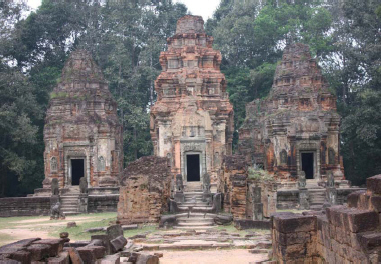
Prasat Prah Ko is located at Roluos between Bakong and Lolei; it is mid-way between Bakong and the road. The complex of Prah Ko is square and surrounded by four enclosing walls with entry towers successively smaller in size. The first two walls are in a ruined state with only vestiges remaining. The first, or outer, enclosure is 450 by 800 meters square with entry towers on the east and west sides. The central area is rectangular and consists of six brick towers arranged in two rows on a low platform.
The base of the Central Sanctuaries has three stairways along the eastern side. The landings are decorated with male and female figures. Sandstone lions on the stairways guard the temple. The only other access to the central level is a single stair way on the west side.
Prasat Lolei
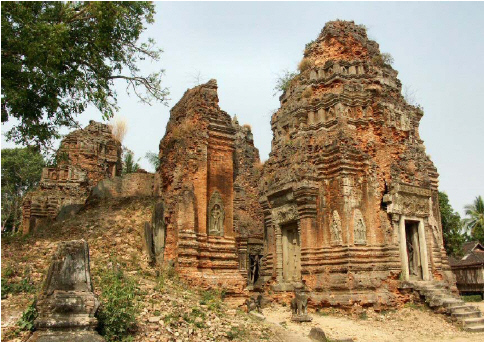 Prasat Lolei is at Roluos, north of Bakong. A modern Buddhist temple is located in the grounds of Lolei near the central towers. The visitors can enter and leave the temple by the stairs at the east.
Prasat Lolei is at Roluos, north of Bakong. A modern Buddhist temple is located in the grounds of Lolei near the central towers. The visitors can enter and leave the temple by the stairs at the east.According to an inscription found at the temple the water in this pond was for use at the capital of Hariralaya and for irrigating the plains in the area. The layout consists of two tiers with laterite enclosing walls and stairway to the upper level in the center of each side. Lions on the landings of the stairways guard the temple.
Prasat Bakong
Only ruins remain as walls that were originally enclosed the temples. The library also made an appearance at Roluos. It is a rectangular building with a curved roof and pediments. A temple often has two libraries, one on each side of the entry tower preceding the Central Sanctuary. The characteristic decorative features of the Roluos group are: a Kala (monster head), the Hindu god Visnu on his mount Garuda, female figures with abundant jewelry, and a preponderance of guardians and Apsaras. Columns are generally octagonal and intricately adorned with delicate leaves.
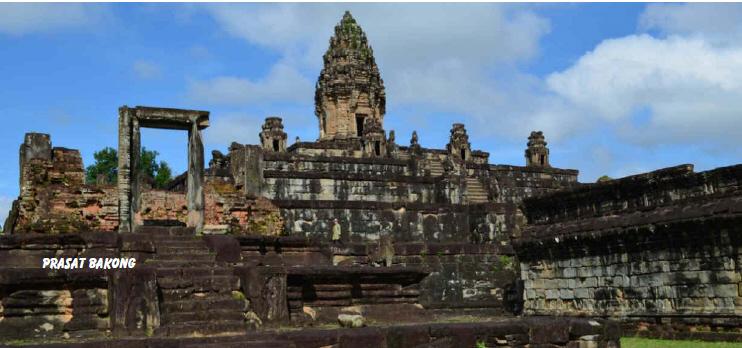
The temple of Bakong is built on an artificial mountain and enclosed in a rectangular area by two walls. It has a square base with five tiers. The first, or outside, enclosure surrounded by a moat with an embankment and causeways on four sides, which are bordered by low Naga balustrades. The second and smaller enclosure has an entry tower of sandstone and laterite in the center of each side of the wall. There were originally 22 towers inside the first enclosures. After passing through the entry tower at the east one comes to a long causeway decorated with large seven-headed serpents across a moat. Long halls on each side lie parallel to the eastern wall. They were probably rest houses for visitors. Two square-shaped brick building at the northeast and southeast corners are identified by rows of circular holes and an opening to the west. On each side of the causeway just beyond the halls there are two square structures with four doors. The inscription of the temple was found in the one on the right.
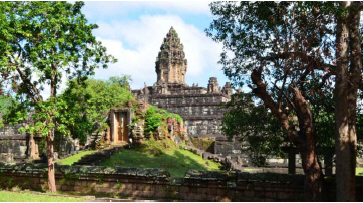
The site of Bakong is an area of 900 by 700 meters, and consists of three concentric enclosures separated by two moats. The main axis is going from east to west. The outer enclosure has neither a wall nor gateway tower and its boundary is the outer moat. Today it is only partially visible. The current access road from National Highway 6 leads at the edge of the second enclosure. The inner moat delimits a 400 by 300 meters and the remains of a laterite wall and four cruciform gateway tower. It is crossed by a wide earthen causeway, flanked by seven-head nagas. Between the two moats there are the remains of 22 satellite temples of brick. The innermost enclosure is bounded by a laterite wall 160 by 120 meters. It contains the central temple pyramid and eight brick temple towers, two on each side. A number of other smaller buildings are also located within the enclosure.
In 802 AD, the first king of Angkor Jayavarman II declared the sovereignty of Cambodia. After ups and downs, he established his capital at Hariharalaya. Few decades later, his successors constructed Bakong in stages as the first temple mountain of sandstone at Angkor. Bakong enjoyed its status as the state temple of Angkor for only a few years, although it is not completely abandoned as there are evidences s that some additions were constructed from the 12th or 13th centuries. Toward the end of the 9th century, Indravarman's son and successor Yasovarman I moved the capital from Hariharalaya to the area north of Siem Reap now known as Angkor, where he founded the new city of Yasodharapura around a new temple mountain called Bakheng.
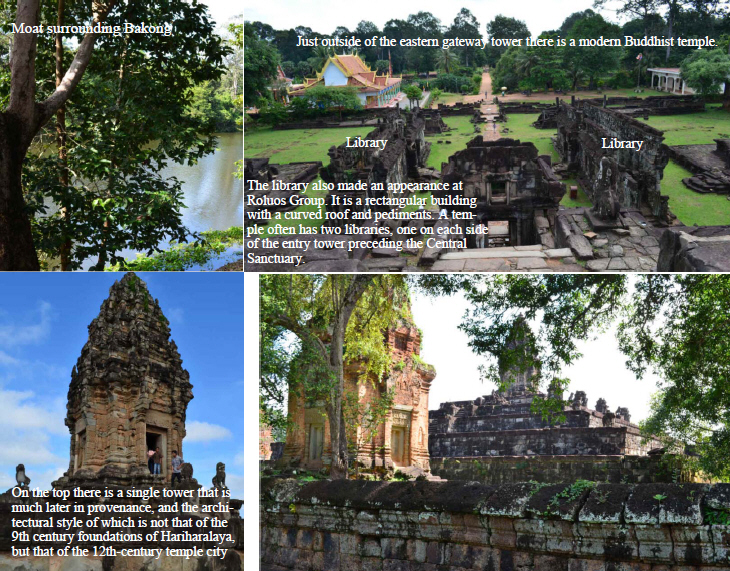
Among "Rolous Group" of temples there are some of the earliest permanent structures built by Khmer. They mark the beginning of classical period of Khmer civilization, dating from the late 9th century. Some were totally built with bricks, others partially with laterite or sandstone. At present it is composed by three major temples: Bakong, Lolei and Preah Ko, and tiny Prasat Prei Monti. At both Bakong and Lolei there are contemporary Theravada buddhist monasteries.
Prasat Prei Monti is a ancient ruin of the Roluos Group and was built during the reign of the Jayavarman III in the middle of the 9th century. This small ruin is standing on the mighty ground which is made from brick. Prasat Prei Montu consists of three ruins and one of them dedicates to the Hindu god Indra.
Here are pictures of Prasat Bakong.


